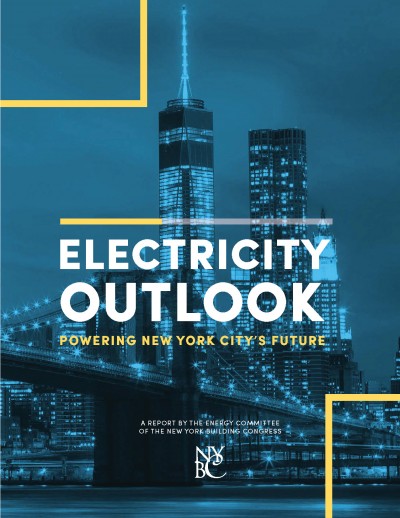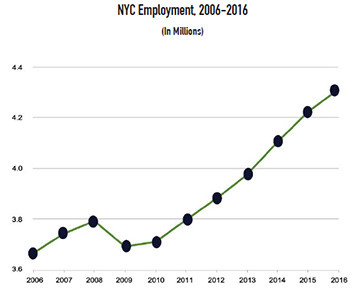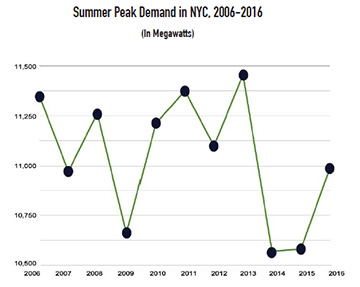
Electricity Outlook 2017: Powering New York City's Future
Powering A Growing Economy
New York City has enjoyed a robust pace of economic expansion in the wake of the Great Recession of 2008-2009. Job levels in the city increased by 620,000 from the low months of 2009, for a gain of 17 percent through 2016, or over 2 percent per year.

The city's population increased to an estimated level of 8,537,673 residents by July 2016, a gain of more than 362,000 people since the 2010 Census. In addition, the city's daytime population, which includes tourists and workers commuting from surrounding regions, swells by over two million each day. New York City attracted a record 60 million visitors during 2016.
The first six years of this decade were also characterized by a surge in new construction in virtually every building sector, including office towers, residential buildings, hotels, stores, schools, and hospitals. This has led to the creation of a host of dynamic new business districts, including the rebuilt World Trade Center, Hudson Yards, and Pacific Park in Brooklyn, as well as the production of nearly 120,000 new housing units throughout the five boroughs.2
Electricity Demand: Planning for the Summer Peak
Despite New York City's strong economic recovery and construction boom, annual energy consumption in the city has actually declined slightly. This is widely credited to increased energy efficiency, especially by residential and commercial consumers who have switched to energy-saving lighting and appliances. Con Edison estimates that these and other conservation measures over the past six years have shaved 350 MW, or 3 percent, from peak summer demand.
 Summer peak demand is the vital criterion for planning and providing the supply of electricity to New York City, whether from locally-based generation facilities, transmission of power into the city, and/or a combination of conservation and demand management response measures.
Summer peak demand is the vital criterion for planning and providing the supply of electricity to New York City, whether from locally-based generation facilities, transmission of power into the city, and/or a combination of conservation and demand management response measures.
The patterns of summer peak demand have been influenced by significant increases in summer temperatures, particularly in 2011, when demand peaked at 11,424 MW, and in 2013, when it reached 11,456 MW. While New York City experienced another hot summer in 2016, demand topped out at 10,990 MW on Thursday, August 11. Temperatures remained consistently high in the mid-90s for the following three days, but the overall need for power was tempered by demand management response measures implemented on Friday and by weekend office closures.
Electricity Supply
Since 2011, New York City's electricity supply has increased by a net of 1,665 MW through 1,205 MW in new generation and another 660 MW from added transmission capacity, less the retirement of 200 MW of aging plant.
As of today, the majority of the city's electricity comes from 24 in-city power plants with a combined capacity of about 10,000 MW, which meets a NYISO requirement that 81.5 percent of the city's electricity generation originate within the five boroughs. Almost all this generation is now fueled by natural gas via several pipelines to the city.3 The balance of electricity comes from imports, via transmission, including from the output of Indian Point.
Indian Point Energy Center
During the summer of 2016, Indian Point Energy Center's two nuclear power plants provided 2,069 MW for the entire Lower Hudson Valley, including New York City.
The license for Indian Point Unit 2 expired in September 2013 and the license for Indian Point Unit 3 expired in December 2015. Under federal law, nuclear power plants are allowed to continue to operate while awaiting a final decision from the Nuclear Regulatory Commission on their license renewal applications.
On January 9, 2017, Entergy and the State of New York announced they had entered into an agreement to permanently cease operations at Indian Point Unit 2 by April 30, 2020, and Indian Point Unit 3 by 2021.
Governor Andrew M. Cuomo's announcement on the settlement indicated that replacement power from "transmission upgrades and efficiency measures totaling over 700 MW are already in-service," and at least one generation resource (the CPV Valley project), which is permitted and under construction, would provide 650 MW of power in the Lower Hudson River Valley starting in 2018.4
According to NYISO's Comprehensive Reliability Plan (CRP) issued on April 11, 2017, New York's bulk power system will meet all applicable reliability criteria through 2026. The CRP does state that recent developments, including the announcement by Entergy and Governor Cuomo to close Indian Point Unit 2 by April 2020 and Unit 3 by April 2021, could impact system resources.
The announced closure of Indian Point's two nuclear power plants by 2021, which in 2016 provided 2,069 MW, will reduce the local energy supply to Westchester County and New York City by 25 percent.
Natural Gas
Ample supplies of natural gas are critical, as almost all in-city electricity generation comes from natural gas burning plants. Demand for natural gas, which has increased by 25 percent in Con Edison's service territory since 2011, has been largely driven by New York City's Clean Heat Program, which has produced a shift from heavy oil to natural gas in over 3,000 buildings. In addition, household demand for natural gas has continued to increase along with the overall population.
Three significant expansions to natural gas pipelines since 2010 have helped offset this increased demand.
- Spectra's 200-mile long project, bringing 800,000 DT/day to the New Jersey-New York area with connections to Con Edison's system in Lower Manhattan, was brought into service in 2013. Con Edison has contracted for 170,000 DT/day of this volume.
- The Transco Rockaway Delivery Lateral, sized to transport up to 647,000 DT/day, coupled with the Northeast Connector Project bringing the first increment of 100,000 DT/day to National Grid's system, was brought into service in mid-May 2015.
- Transco's New York Bay Expansion project, which will bring an additional 115,000 DT/day to National Grid, is due into service in November 2017.
Shale Gas
Vast quantities of natural gas are locked in the Marcellus Shale, a deposit submerged between the Appalachian Range that extends from Tennessee, West Virginia, Pennsylvania, and into New York State, which contains an estimated 15 percent of the total shale gas reserve. Considerable volumes of shale gas from Pennsylvania are currently supplying natural gas to New York City (Con Edison received 81 percent of its gas supply from shale gas in 2015). Vertical wells in seven Upstate New York counties have also been producing natural gas from the Marcellus Shale for the past five decades. In December 2014, however, Governor Cuomo announced a ban on hydraulic fracking in New York State, the method currently used to extract shale gas, over concerns for health risks.5
Transmission
The transmission issue for Downstate New York is stark. The region known as Southeast New York, which comprises New York City, Long Island, and the Lower Hudson Valley, uses 58 percent of statewide electricity, but generates only 40 percent of its electricity supply. The gap must be filled by transmission lines to the city and the metro area.
Since 2011, there have been two significant investments in transmission to New York City:
- the 660 MW High Voltage Direct Current (HVDC) line between Ridgefield, New Jersey and New York City; and
- the Transmission Owners Transmission Solutions (TOTS) investment by Con Edison and the New York Power Authority (NYPA), as part of a plan to solve reliability needs under the Indian Point Contingency Plan. The Marcy South Series Compensation project, a component of TOTS, went into service in June of 2016 and contributes about 400 MW of additional electricity resources.
2 New York Building Congress, New York City Construction Outlook: 2016-2018 (New York City, 2016), p. 3.
3 NYC Mayor's Office of Sustainability, New York City's Roadmap to 80x50 (New York City, 2016).
4 Office of Governor Andrew M. Cuomo, Pressroom. (Jan. 9, 2017). Governor Announces 10th Proposal of the 2017 State of the State: Closure of the Indian Point Nuclear Plant by 2021 [Press release].
5 Thomas Kaplan, "Citing Health Risks, Cuomo Bans Fracking in New York State," New York Times, Dec. 17, 2014, New York Edition, NY/Region sec.



